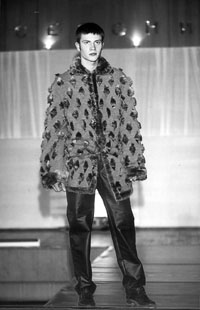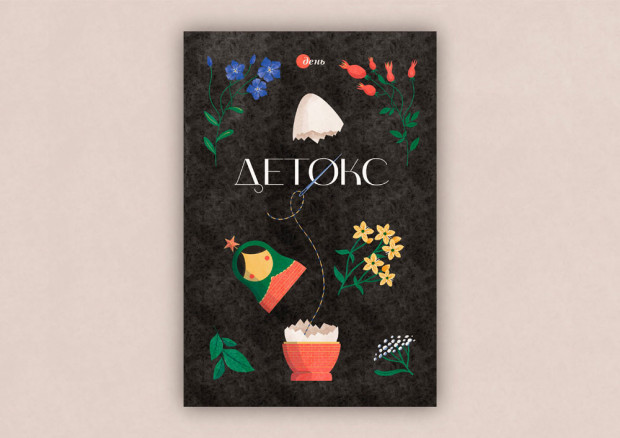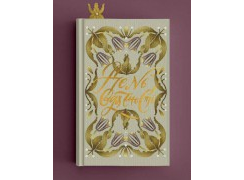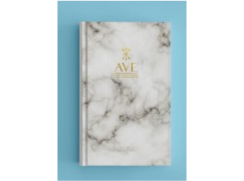Fashion Festival in the Center of Europe

As soon as I came to Mukacheve, local residents told me this city is the geographical center of Europe, which obviously vested them with responsibility and ambitions: to do everything as befits such an august center. You must agree that this is quite an incentive.
Society, as well as nature, is known to loathe a vacuum: no sooner had the Smirnoff contest quit the Ukrainian horizon (for purely economic reasons) a little over a year ago, than the vacancy was filled by a similar but, what especially pleases us, Ukrainian function. Moreover, this occurred far from the capital. The old Western Ukrainian city of Mukacheve has hosted for the second time the contest of young Ukrainian fashion design students. This drew a full house: Transcarpathia was visited by representatives of Lviv, Khmelnytsky, Lviv, and Ivano-Frankivsk institutes. Naturally, the hosts also took part in the competition, for the Mukacheve Technological Institute is Ukraine’s youngest institution of higher education training designers for light industry.
It should be noted that a certain inexperience of the hosts in holding functions of this level had contradictory results: on the one hand, the contest was informal and very ingenuous, with the results being evaluated by a jury, but, on the other hand, there was a number of formal missteps, the main one being the very name of the contest. By force of the confluence of many circumstances, the function was called Seasons of Fashion in Mukacheve, which had nothing to do with the well- known Seasons of Fashion in Kyiv. No doubt, this did harm to both the brand-new organizer, but the next contest will bear a different title.
As to the contest itself, it was very indicative of the minds of the younger generation of Ukrainian designers. Oddly enough, our young people were not in the least taken by European postmodern gimmicks or cosmopolitan minimalism. On the contrary, they were mainly concerned about creating their own Ukrainian, fashion, so the young fashion designers were constantly asking the august members of the jury (headed by Viktoriya Hres, with Hanna Babenko also a jury member) at the press conference whether they should stick to European fashion or go their own way.
But those were in fact pro forma questions, because the young fledgling hawks of haute couture proved to have made the final choice on their own. Most festival participants chose precisely the second way. There were a lot of intrinsically ethnic motives in the three nominations: Ready to Wear, the Birth of a Couturier, and Art. This may have been influenced by the fact that this is part of the college curriculum: as we understood, the latter holds enough place for the folk costume. In general, this theme ran through the whole festival program, and even the round- table discussion held on the next day ended up in the presentation of the book Ukrainian Clothes by a Lviv art researcher Halyna Stelmashchuk.
However, this common feature apart, all the nominations differed from each other. What looked the most attractive was ready to wear, with the only first price having been awarded precisely in this nomination. The pace was set here by the hosts who presented the silver-cosmic (N. Kushnirchuk, L. Homenko’s In Flight), the colored hosiery (N. Toba’s Without Sensation), and, naturally, the very moderate and, if I may say so, adapted national (O. Morozova, N. Buchok’s Gray Landscapes) themes. And the coveted prize was awarded to the representatives of Khmelnyk (O. Sydoruk, The Unheard Cry of the Soul), the youngest Ukrainian college’s potential was displayed for all to see. (N.B. This was a truly youth oriented contest: suffice it to recall an endearing tradition to attach names — and even “descriptions” — to collections, often in poetic form). The Birth of a Couturier nomination seemed to raise considerable doubts among some jury members, including the chairperson, renowned Ukrainian designer Viktoria Hres. Indeed, can there be even a suggestion of true haute couture in student works? Moreover, the students interpreted this name of the nomination as cancellation of any responsibility before the potential buyers: they inspiringly “created” high fashion without worrying about whether anybody other than they might ever like or agree (and be able) to wear it. During the post-contest press conference, jury members Hanna Babenko and Viktoria Hres, who know only too well the true work of a designer, tried to persuade them to come down to earth and face the customer. In this nomination, the Space Extravaganza collection, with its specially-ordered and beautifully-made accessories, by the Lviv-based Yu. Zhuk was named the best.
As to the Art nomination (an equivalent to avant-garde), I don’t think it should exist in our time. All we need to do is to expand the bounds of pret-a-porter (under the slogan, one can wear anything that can be worn), but if even these bounds prove to be narrow, this will amount to art-fashion.
Indeed, this collection included pieces that looked like solid pret-a- porter: Time Beyond the Skyline by E. Sedoukhova and N. Velihurska and De Profundis by O. Ocheretny were judged the best.
The Grand Prix found no home this year, for the jury was too strict. However, this only spurred the students who promised that next year the Grand Prix will surely find a worthy place.
Returning to the problem of the center of Europe, I learned and understood the following during my sojourn in the fabulously beautiful town of Mukacheve. In general, there are several centers of Europe: the latter is neither round nor square, so the center’s whereabouts depends on how one measures and, hence, is subject to dispute. What is indisputable is this: if people, like the Mukacheve contest organizers, strive to live according to European style and make a genuine effort to this end, they will live in the center of Europe or, to be more exact, the center will be where they live.






